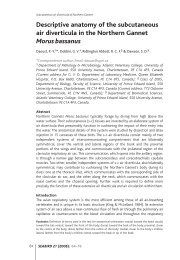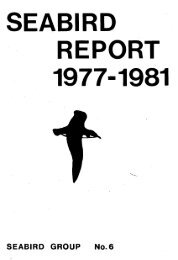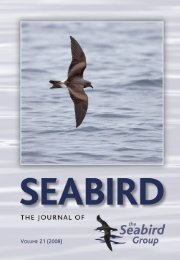You also want an ePaper? Increase the reach of your titles
YUMPU automatically turns print PDFs into web optimized ePapers that Google loves.
160 B. CADIOU Atlantic <strong>Seabird</strong>s 3(4)<br />
Laying period and observed variability Despite the limitations of backcalculation<br />
of laying date from chick age (see Methods), the large sample sizes<br />
and consistency of methods in the current study indicate that the overall laying<br />
period extends from the end of April to early August and shows high interannual<br />
variability, with 50% of laying ranging over 6 weeks, from mid May to early<br />
July; 90% of laying appears to be less variable, ranging over 4 weeks, from mid<br />
June to mid July (Fig. 1). <strong>The</strong> situation between 1975 and 1996 is not known<br />
because very few chicks were ringed and aged. However, from samples of 17<br />
and 22 chicks ringed and measured in August 1986 and 1990 respectively (J.-P.<br />
Cuillandre unpubl. data), it appears that the breeding period in both years<br />
occurred somewhere between that recorded in 1975 and 1997-1999 (Fig. 1), and<br />
seemed to be earlier in 1986 than in 1990.<br />
<strong>The</strong> late 1998 breeding season in Brittany indicated a temporal pattern<br />
placed between the one recorded in Wales and the one recorded in northern<br />
Scotland (Davis 1957; Scott 1970; Ratcliffe et al. 1996; Mainwood et al. 1997).<br />
Such a great delay in a single colony seems not to have been recorded elsewhere<br />
for European Storm-petrels, and appears to be very uncommon for other<br />
seabirds, although one case of late breeding was reported for European Stormpetrels<br />
on Mousa (Ratcliffe et al. 1998b). Davis (1957) and Scott (1970), over<br />
seven breeding seasons on Skokholm, found that 50% of laying ranged over less<br />
than 10 days in an early year to other more typical periods. On Skokholm and<br />
Skomer, the Manx Shearwater Puffinus puffinus also exhibited a high constancy<br />
in laying (Brooke 1990), but one late season has been recorded on Rum, western<br />
Scotland (K. Thompson, pers. comm.).<br />
Factors influencing the timing of laying Several factors can influence the<br />
duration of the breeding period in seabirds. Among European Storm-petrels,<br />
young, first-time breeders tend to breed later in the season than experienced<br />
breeders (Scott 1970), but population size in the Molène archipelago remained<br />
similar from 1997 to 1998, and the large increase in breeding numbers recorded<br />
in 1999 was not associated with a late breeding season (Fig. 1). Higher densities<br />
of breeders can induce an earlier breeding in seabirds (Danchin 1988; Harris &<br />
Wanless 1988), but in the present study all available data on laying, from<br />
different colonies and different areas within colonies, with different densities,<br />
were pooled together. Massive predation in consecutive years on eggs and<br />
chicks at some Black-legged Kittiwake Rissa tridactyla colonies in Brittany<br />
leads to a progressive delay in breeding from the end of April or early May<br />
(usual dates) to early June (J.-Y. Monnat & B. Cadiou unpubl. data). Predation<br />
by gulls, especially Great Black-backed Gulls, mainly on pre-breeding and<br />
breeding European Storm-petrels, has increased since the beginning of the<br />
1990s in the Molène archipelago (Cuillandre et al. 1989; Cadiou 1998 and








